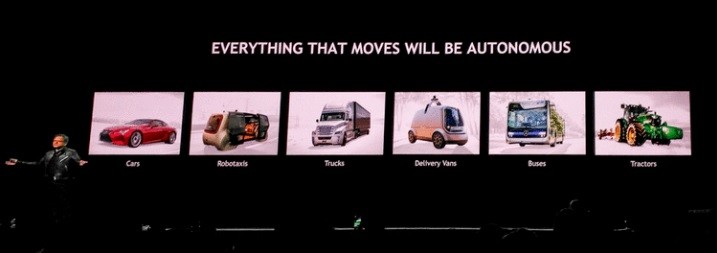
Five years ago Uber nearly singlehandedly wiped out the prospect of a self-driving car industry with the inept management of its autonomous vehicle testing in Phoenix which led to a fatal crash. The massive misstep instantly vaporized tens of billions of dollars of Uber’s market cap and sent the company’s robotaxi development arm into a tailspin from which it was unable to recover.
It had only been a few months before – at the CES event in Las Vegas – that Nvidia had proudly trumpeted its newfound relationship with Uber – just one of several dozen autonomous vehicle collaborations announced by Nvidia. But the Uber crash cast a pall that caused Nvidia to pause its own autonomous vehicle testing and, ultimately, dial back on its autonomous vehicle grandstanding.
A measure of that impact was evident in Nvidia CEO Jensen Huang’s keynote at this week’s Nvidia GTC event. Huang’s keynotes have become a tech industry bellwether as the company’s GPU processing platforms have risen to prominence across the spectrum of emerging high-end applications.
While Nvidia remains an actively engaged participant in the development of autonomous vehicle technology – the topic received scant mention in Huang’s keynote this year. Instead, generative AI and large language model inference engines got the spotlight as Nvidia announced its launch of the Nvidia AI Foundation – a cloud-based platform developed in partnership with Microsoft, Google, and Oracle to deliver processing power for a wide range of AI-centric applications.
Huang announced its Omniverse Managed Cloud Service – what he described as AI’s iPhone moment – delivering four configurations from a single architecture. The four configurations included L4 for AI video, L40 for Omniverse and graphics rendering, H100 PCIE for scaling out large language model inference engines, and Grace-Hopper for recommender systems and vector databases.
Huang’s more than hour long presentation was a typical tour de force of all of Nvidia’s technological advances in GPU and server technology along with a review of various strategic engagements and technology deployments. The fact that autonomous vehicle tech got short shrift – while automotive factory planning and automation did get a fair bit of attention – was yet another hint that autonomous vehicle tech has been consigned to the sidelines.
The dark cloud of Uber’s failure lingers over the industry. Even semi-autonomous vehicle operator Tesla struggles to explain suspicious Autopilot and full-self-driving misbehavior (crashes – fatal and otherwise) to regulators. Autonomous vehicle developers have been forced to extend their viability forecasts. Some have given up altogether.
Cruise CEO Kyle Vogt told Fortune Magazine this week that “within 10 years driving a car will be a hobby like riding horses is today.” He added that within five years the majority of people would get around cities in autonomous vehicles.
Sadly, Vogt’s sanguine view is shared by few.
While Vogt may foresee a very short time-line to the arrival of millions of autonomous vehicles on city streets – vehicles the deployment of which Vogt believes does not require National Highway Traffic Safety Administration exemptions – the dim reality is manifest in the stuttering performance of Cruise vehicles on the streets of San Francisco today.
What was once sexy and worthy of spotlighted emphasis at Nvidia’s GTC event, has now become an awkward and frightening embarrassment. The promise of autonomous vehicles transforming society is being lost in the focus on the downside – potential catastrophic failures and exorbitant expenditures with little short-term prospect of revenue.
Interestingly, the technology that has seized the spotlight – generative AI – is itself a pricey proposition with ill-defined commercialization opportunities. While autonomous tech transitions through its trough of despair, ChatGPT and its ilk are riding high on the ether of unlimited potential.
In some respects, the collateral damage from the fatal Uber crash five years ago was Nvidia’s diminished enthusiasm for autonomous vehicle tech. The sector is in dire need of leadership and vision – something that Nvidia is imparting to the AI sector in spades.
It might be time for Nvidia to get its robotaxi mojo rolling again. The fatal Uber crash was a devastating blow – but it ought not to be fatal to the entire sector. Autonomous vehicle tech remains a strategic focus for Nvidia and retains the promise of societal transformation. This is not time to throw in the towel.
Also Read:
Mercedes, VW Caught in TikTok Blok
AAA Hypes Self-Driving Car Fears
Share this post via:





Flynn Was Right: How a 2003 Warning Foretold Today’s Architectural Pivot